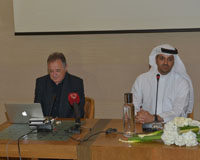Contact Center
.
15 March 2016
Bahrain National Museum Hosts a Lecture on
‘Green archaeology: The case of Qal’at al-Bahrain’


Bahrain National Museum hosted a lecture on ‘Green archaeology: The case of Qala’at al-Bahrain’ on 15 March 2016. The event coincides with the Environment Month and was organized by the Supreme Council for the Environment. The talk was presented by Dr. Pierre Lombard, director of the French archeological mission in Bahrain, who briefed the audience about the main environmental aspects of UNESCO World Heritage site of Qala’at al-Bahrain.
Dr. Lombard presented major changes that have occurred with regard to Qala’at al Bahrain archaeological site, including the surrounding gardens and palm trees, while focusing on the strong relationship between environmental elements and the neighboring urban elements. The 8 meter high archaeological mound, formed by successive layers of human occupation, goes back to around the 3rd Millennium BC to the 17th century AD. Dr. Lambard lauded the efforts deployed by Bahrain Authority for Culture & Antiquities in preserving the urban and environmental characteristics of Qala'at al Bahrain archaeological site (Bahrain Fort).
Dr. Lombard, after recalling the main archaeological features of the site, stressed the importance of archaeological excavations and the first environmental results achieved by the French Archaeological Mission in determining the exact natural history of Bahrain in terms of archaeobotany and archaeozoology.
The lecture comes as part of BACA’s keenness to spread awareness concerning the latest archaeological discoveries of Bahrain and the importance of informing the public about excavations carried out throughout the Kingdom of Bahrain. The lecture comes at a time when environmental studies are becoming an essential element in archaeology. Indeed, for several decades, environmental studies constitute an essential part of the archaeological process. Geomorphologists, archaeobotanists, archaeozoologists, and many other specialists now work alongside archaeologists in a common approach to rebuild the former landscape that surrounded their settlement sites in the remote past.
It is worth mentioning that Dr. Pierre Lombard has been conducting archaeology projects for more than 20 years in Bahrain and he is currently working as the head of the French mission in Bahrain Fort. Given its historical importance, the site figures on UNESCO World Heritage since 2005.







